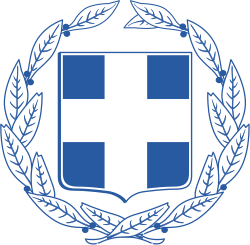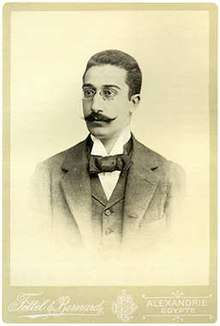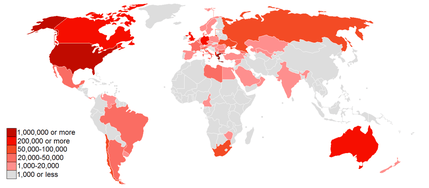Greeks in Egypt
| Total population | |
|---|---|
| 8800[1][2] | |
| Regions with significant populations | |
| Alexandria, Cairo | |
| Languages | |
| Greek · Egyptian Arabic · French | |
| Religion | |
| Greek Orthodox Church |
There has been a large community of Greeks in Egypt, also known as Egyptiotes (Greek: Αιγυπτιώτες), from the Hellenistic period until the aftermath of the Egyptian revolution of 1952, when most were forced to leave.
Antiquity
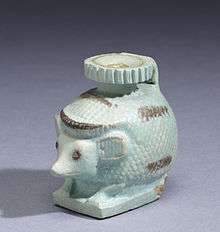
Greeks have been present in Egypt since at least the 7th century BC. Herodotus visited Egypt in the 5th century BC and claimed that the Greeks were one of the first groups of foreigners that ever lived in Egypt.[3] Diodorus Siculus claimed that Rhodian Actis, one of the Heliadae, built the city of Heliopolis before the cataclysm; likewise the Athenians built Sais. Siculus reports that all the Greek cities were destroyed during the cataclysm, but the Egyptian cities including Heliopolis and Sais survived.[4]
First historical colonies
According to Herodotus (ii. 154), King Psammetichus I (664–610 BC) established a garrison of foreign mercenaries at Daphnae, mostly Carians and Ionian Greeks.
In 7th century BC, after the Greek Dark Ages from 1100-750 BC, the city of Naucratis was founded in Ancient Egypt. It was located on the Canopic branch of the Nile river, 45 mi (72 km) from the open sea. It was the first and, for much of its early history, the only permanent Greek colony in Egypt; acting as a symbiotic nexus for the interchange of Greek and Egyptian art and culture.
At about the same time, the city of Heracleion, the closest to the sea, became an important port for Greek trade. It had a famous temple of Heracles. The city later sank into the sea, only to be rediscovered recently.
From the time of Psammetichus I onwards, Greek mercenary armies played an important role in some of the Egyptian wars. One such army was led by Mentor of Rhodes. Another such personage was Phanes of Halicarnassus.
Hellenistic times
Rule of Alexander the Great (332–323 BC)
Alexander the Great conquered Egypt at an early stage of his conquests. He respected the pharaonic religions and customs and he was proclaimed Pharaoh of Egypt. He established the city of Alexandria. After his death, in 323 BC, his empire was divided among his generals. Egypt was given to Ptolemy I Soter, whose descendants would give Egypt her final royal dynasty — a glittering one, largely Greek in flavor. Its capital was Alexandria. Ptolemy added legitimacy to his rule in Egypt by acquiring Alexander's body. He intercepted the embalmed corpse on its way to burial, brought it to Egypt, and placed it in a golden coffin in Alexandria. It would remain one of the famous sights of the town for many years, until probably destroyed in riots in the 3rd century AD.[5]
The Ptolemaic dynasty (323–30 BC)
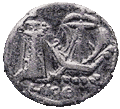
The initial objective of Ptolemy's reign was to establish firm and broad boundaries to his newly acquired kingdom. That led to almost continuous warfare against other leading members of Alexander's circle. At times he held Cyprus and even parts of mainland Greece. When these conflicts were over, he was firmly in control of Egypt and had strong claims (disputed by the Seleucid dynasty) to Palestine. He called himself king of Egypt from 306 BC. By the time he abdicated in 285 BC, in favour of one of his sons, the Ptolemaic dynasty was secure. Ptolemy and his descendants showed respect to Egypt's most cherished traditions — those of religion — and turned them to their own advantage. Alexandria became the centre of the Greek and Hellenistic world and the centre of international commerce, art and science. The Lighthouse of Alexandria was one of the Seven Wonders of the Ancient World while during the reign of Ptolemy II Philadelphus, the Library of Alexandria was the biggest library in the world until it was destroyed. The last Pharaoh was a Greek princess, Cleopatra VII, who took her own life in 30 BC, a year after the battle of Actium.[5]
Roman and Byzantine Egypt

Under Greco-Roman rule, Egypt hosted several Greek settlements, mostly concentrated in Alexandria, but also in a few other cities, where Greek settlers lived alongside some seven to ten million native Egyptians.[6] Faiyum's earliest Greek inhabitants were soldier-veterans and cleruchs (elite military officials) who were settled by the Ptolemaic kings on reclaimed lands.[7][8] Native Egyptians also came to settle in Faiyum from all over the country, notably the Nile Delta, Upper Egypt, Oxyrhynchus and Memphis, to undertake the labor involved in the land reclamation process, as attested by personal names, local cults and recovered papyri.[9] It is estimated that as much as 30 percent of the population of Faiyum was Greek during the Ptolemaic period, with the rest being native Egyptians.[10] By the Roman period, much of the "Greek" population of Faiyum was made up of either Hellenized Egyptians or people of mixed Egyptian-Greek origins.[11] By the time of Roman emperor Caracalla in the 2nd century CE, "genuine" ethnic Egyptians could be easily differentiated from Alexandria's Greeks "by their speech."[12]
While commonly believed to represent Greek settlers in Egypt,[13][14] the Fayum mummy portraits instead reflect the complex synthesis of the predominant Egyptian culture and that of the elite Greek minority in the city.[10] According to Walker, the early Ptolemaic Greek colonists married local women and adopted Egyptian religious beliefs, and by Roman times, their descendants were viewed as Egyptians by the Roman rulers, despite their own self-perception of being Greek.[15] The dental morphology[16] of the Roman-period Faiyum mummies was also compared with that of earlier Egyptian populations, and was found to be "much more closely akin" to that of ancient Egyptians than to Greeks or other European populations.[17] Victor J. Katz notes that "research in papyri dating from the early centuries of the common era demonstrates that a significant amount of intermarriage took place between the Greek and Egyptian communities".[18]
Medieval Islamic and Ottoman era
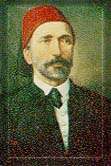
Greek culture and political influence continued and perhaps reached its most influential times during the Ottoman Caliphate, which witnessed many Ottoman Sultans and Pashas of Greek ancestry rule over the Ottoman Empire in general, and Egypt in particular. Other notable Greeks in Egypt during the Ottoman period included Damat Hasan Pasha from the Morea, a governor of Egypt. Raghib Pasha, born in Greece to Greek parents, served as Prime Minister of Egypt. During the Ottoman Caliphate, Pargalı Ibrahim Pasha, Grand Vizier to Suleiman the Magnificent from 1520–1566, is perhaps the best known.
Many Greek Muslims from Crete (often confusingly called Cretan Turks) were resettled in Egypt, Libya, Lebanon, and Syria by Sultan Abdul Hamid II after the Greco-Turkish War of 1897 that resulted in the autonomy of Crete (see the example of al-Hamidiyah, a largely Cretan Greek Muslim village in Syria).
Modern times
Greek community
In 1907, the census showed 6924 Greeks living in Egypt. By 1940, Greeks numbered about 25,120. The Greek community in Alexandria lived around the church and convent of Sabbas the Sanctified. In the same area there was a guest house for Greek travelers, a Greek hospital and later a Greek school. The Greek Orthodox bishop was based in Damietta in the church of Nikolaos of Myrna.
In Cairo, the first organised Greek community was founded in 1856, with the community based in three main neighbourhoods: Tzouonia, Haret el Roum (Street of the Greeks), and in Hamzaoui. The patriarchate was based in Saint Mark's Coptic Orthodox Cathedral, Azbakeya. The monastery of Saint George, in Old Cairo still survives. The monastery is surrounded by a huge wall and topped by a stone tower. Within its walls there was a Greek hospital, a school and housing for the elderly and poor.
In addition to the Greek communities of Alexandria and Cairo, there were the organised Greek communities of Mansoura, founded in 1860, Port Said, founded in 1870, Tanta in 1880, and the community of Zagazig in 1850. There were fifteen smaller communities across Egypt and mainly around Cairo and Alexandria. In Upper Egypt, the oldest ancient Greek community was the one of Minia which was founded in 1812.
The first banks in Egypt were crafted by Greeks, including the Bank of Alexandria, the Anglo-Egyptian bank (Sunadinos family / Συναδινός), and the General Bank of Alexandria. Also, it was the Greek agriculturists and farmers that first systematically and with scientific planning, cultivated cotton and tobacco. They improved the quantity and quality of production and dominated cotton and tobacco exports. Notable families in tobacco commerce were the Salvagos (Σαλβάγκος), Benakis (Μπενάκης), Rodochanakis (Ροδοχανάκης) and Zervoudachis (Ζερβουδάκης).[19] The tobacco cultivars used for cigarette manufacturing, e.g., by Kyriazi Freres, were of Greek origin. A thriving commerce between Greece and Egypt was thus established. Other areas of interest for the Greeks in Egypt were foods, wine, soap, wood crafts, printing.
In the food industry, the macaroni industries of Melachrinos (Μελαχροινός) and Antoniados (Αντωνιάδης) were well known. Another example was the cheese and butter production of Archyriou (Αργυρίου), Roussoglou (Ρουσσόγλου) and Paleoroutas (Παλαιορούτας). Chocolate-Biscuits and Toffee producers were: Daloghlou (Δαλόγλου), Russos (Ρούσσος), Repapis (Ρεπάπης); Oil-soaps-vegetable fats (Salt & Soda) producers like Zerbinis (Ζερμπίνης) were based in Kafr al-Zayat. There were many Greek theatres and cinemas. Major Greek newspapers were Ta grammata (Τα Γράμματα), "Tahidromos"(Ταχυδρόμος), and Nea Zoi (Νέα Ζωή).[20] The Greek community in Egypt has produced numerous artists, writers, diplomats and politicians, the most famous being the poet Constantine P. Cavafy (Κωνσταντίνος Καβάφης), also the painter Konstantinos Parthenis (Κωνσταντίνος Παρθένης).
During the Balkan Wars, the Greek communities of Egypt sent volunteers, funded hospitals, and accommodated families of the soldiers. During World War II (1940–1945), more than 7000 Greeks fought for the Allies in the Middle East; 142 died. Their financial contribution reached 2500 million Egyptian pounds.[21] After the Suez Crisis, the British and French laborers left while the Greeks stayed.[22]
Patriarchate of Alexandria
Greek-Egyptian benefactors

The emergence of a Greek aristocracy of rich industrialists, commercants and bankers created the legacy of Greek-Egyptian philanthropism. These benefactors donated large amounts for the building of schools, academies, hospitals and institutions in both Egypt and Greece. Michail Tositsas donated large amounts for the building of the Athens University, the Amalio Orphanage and the Athens Polytechnic. His wife Eleni Tositsa donated the land for the National Archaeological Museum of Athens. George Averoff also contributed to the building of the National Technical University of Athens, the Evelpidon Military Academy and the donation of the cruiser Averoff to the Hellenic Navy. Emmanouil Benakis contributed to the building of the National Gallery of Athens, while his son Antonis Benakis was the founder of the Benaki Museum. Other major benefactors include Nikolaos Stournaras, Theodoros Kotsikas, Nestoras Tsanaklis, Konstantinos Horemis, Stefanos Delta, Penelope Delta, Pantazis Vassanis and Vassilis Sivitanidis.[19]
Exodus
The exodus of Greeks from Egypt started before the revolution of 1952. With the establishment of the new sovereign regime of Gamal Abdel Nasser, rise of Pan-Arab nationalism, and the subsequent nationalisation of many industries in 1961 and 1963, thousands of Greek employees decided to abandon the country. Many of them emigrated to Australia, the United States, Canada, South Africa, Western Europe, and Greece. Many Greek schools, churches, small communities and institutions subsequently closed, but many continue to function to this day. The Nasser regime saw a big exodus of the Greeks from Egypt, but most of the minority left the country either before or after the period 1952-1970. The Arab-Israeli wars of 1956 and 1967 contributed to the uprooting of the sizeable Greek community in the Suez Canal cities, especially Port Said.
Today
Today the Greek community numbers officially about 5,000 people[23] although many of Greek origin are now counted as Egyptian, having changed their nationality. In Alexandria, apart from the Patriarchate, there is a Patriarchal theology school that opened recently after 480 years being closed. Saint Nicholas church in Cairo and several other buildings in Alexandria have been recently renovated by the Greek Government and the Alexander S. Onassis Foundation. Saint George's church in Old Cairo is undergoing restoration to end in 2014. During the last decade, there has been a new interest from the Egyptian government for a diplomatic rapprochement with Greece and this has positively affected the Greek Diaspora. The Diaspora has received official visits of many Greek politicians. Economic relationships between Greece and Egypt have expanded. As of 2010, Egypt has received major Greek investments in banking, tourism, paper, the oil industry, & many others. In 2009, a five-year cooperation-memorandum was signed among the NCSR Demokritos Institute in Agia Paraskevi, Athens and the University of Alexandria, regarding Archeometry research and contextual sectors.[24]
Notable Greeks from Egypt
Greeks of Cyrene (the Cyrenaica is a region corresponding to modern eastern Libya) are also included, as during antiquity it held close relations to the Egyptian kingdoms, and at some points, also used to be a part of the Ptolemaic kingdom. The presence of an asterisk (*) next to a person's name denotes that the person was born outside of Egypt, however the most part of this person's life or most important work occurred while in Egypt.
| Antiquity
7th - 1st century B.C.E |
Roman and Byzantine era
1st - 7th century C.E. |
Arab Caliphate &
Ottoman era 7th - 19th century [25] |
Contemporary
20th - 21st century | ||||
|---|---|---|---|---|---|---|---|
| Battus I of Cyrene *
Ruler, 7th century B.C.E., Cyrene |
Hero of Alexandria
Engineer, 1st century B.C.E. or C.E., Alexandria |
Jean Dessès
Fashion designer, 1904 - 1970, Alexandria | |||||
| Theodorus of Cyrene
Mathematician, 5th century B.C.E., Cyrene |
Philo
Philosopher, 20 B.C.E - 50 C.E., Alexandria |
||||||
| Aristippus
Philosopher, 435 - 356 B.C.E., Cyrene |
Chaeremon of Alexandria
Philosopher, 1st century C.E., Alexandria |
Alexander Iolas
Art collector, 1907 - 1987, Alexandria | |||||
| Aristaeus the Elder *
Mathematician, 370 - 300 B.C.E., Alexandria |
Menelaus of Alexandria
Mathematician, 70 - 140 C.E., Alexandria |
George Averoff *
Businessman, 1815 - 1899, Alexandria |
Kimon Evan Marengo
Cartoonist, 1907 - 1988, Zifta | ||||
| Ptolemy I Soter *
Ruler, 367 - 282 B.C.E., Alexandria |
Ptolemy
Geographer, 90 - 168 C.E., Alexandria |
Emmanouil Benakis *
Politician, 1843 - 1929, Alexandria |
Nikos Tsiforos
Director, 1909 - 1970, Alexandria | ||||
| Philitas of Cos *
Poet, 340 - 285 B.C.E., Alexandria |
Sosigenes of Alexandria
Astronomer, 1st century C.E., Alexandria |
Ioannis Pesmazoglou *
Economist, 1857 - 1906, Alexandria |
|||||
| Theodorus the Atheist
Philosopher, 340 - 250 B.C.E., Cyrene |
Thrasyllus of Mendes
Mathematician, 1st century C.E., Alexandria |
||||||
| Euclid *
Mathematician, 325 - 265 B.C.E., Alexandria |
Clement of Alexandria
Theologian, 150 - 211 C.E., Alexandria |
Constantine Cavafy
Poet, 1863 - 1933, Alexandria |
Mary Giatra Lemou
Author, 1915 - 1989, Alexandria | ||||
| Magas of Cyrene
Ruler, 317 - 250 B.C.E., Cyrene |
Origen
Theologian, 185 - 251 C.E., Alexandria |
Antonis Benakis
Businessman, 1873 - 1954, Alexandria |
Dinos Iliopoulos
Actor, 1915 - 2001, Alexandria | ||||
| Ptolemy II Philadelphus *
Ruler, 309 - 246 B.C.E., Alexandria |
Plotinus
Philosopher, 203 - 270 C.E., Alexandria |
Dimitrios Kasdaglis *
Athlete, 1872 - 1931, Alexandria |
|||||
| Callimachus
Poet, 305 - 240 B.C.E., Cyrene |
Diophantus
Mathematician, ~210 - ~290 C.E., Alexandria |
Penelope Delta
Author, 1874 - 1941, Alexandria |
Voula Zouboulaki
Actor, 1924, Cairo | ||||
| Ctesibius
Engineer, 285 - 222 B.C.E., Alexandria |
Catherine of Alexandria
Theologian, 282 - 305 C.E., Alexandria |
Konstantinos Parthenis
Painter, 1878 - 1967, Alexandria |
Jani Christou
Composer, 1926 - 1970, Cairo | ||||
| Conon of Samos *
Astronomer, 280 - 220 B.C.E., Alexandria |
Pappus of Alexandria
Mathematician, 290 - 350 C.E., Alexandria |
Konstantinos Tsaldaris
Politician, 1884 - 1970, Alexandria |
Nelly Mazloum
Dancer, 1929 - 2003, Alexandria [26] | ||||
| Eratosthenes
Mathematician, 276 - 194 B.C.E., Alexandria |
Theon of Alexandria
Mathematician, 335 - 405 C.E., Alexandria |
Constantin Xenakis
Artist, 1931, Cairo | |||||
| Apollonius of Rhodes
Poet, 3rd century B.C.E., Alexandria |
Hypatia
Mathematician, 370 - 416 C.E., Alexandria |
||||||
| Sostratus of Cnidus *
Engineer, 3rd century B.C.E., Alexandria |
Palladas
Poet, 4th century C.E., Alexandria |
Antigone Costanda
Model, 1934, Alexandria | |||||
| Hypsicles
Mathematician, 190 - 120 B.C.E., Alexandria |
Isidore of Alexandria
Philosopher, 450 - 520 C.E., Alexandria |
Georges Moustaki
Singer, 1934 - 2013, Alexandria | |||||
| Dionysius of Cyrene
Mathematician, 2nd century B.C.E., Cyrene |
Hierocles of Alexandria
Philosopher, 5th century C.E., Alexandria |
||||||
| Eudorus of Alexandria
Philosopher, 1st century B.C.E., Alexandria |
Hesychius of Alexandria
Author, 5th century C.E., Alexandria |
Manos Loïzos
Composer, 1937 - 1982, Alexandria | |||||
| Aretaphila of Cyrene
Revolutionary, 1st century B.C.E., Cyrene |
George Leonardos
Author, 1937, Alexandria | ||||||
| Cleopatra VII
Ruler, 69 - 30 B.C.E., Alexandria |
Nikos Perakis
Director, 1944, Alexandria | ||||||
| Demetrio Stratos
Singer, 1945 - 1979, Alexandria | |||||||
| Demis Roussos
Singer, 1946 - 2015, Alexandria | |||||||
| Andreas Gerasimos Michalitsianos
Astronomer, 1947 - 1997, Alexandria | |||||||
| Nora Valsami
Actress, 1948, Cairo | |||||||
| Alkistis Protopsalti
Singer, 1954, Alexandria | |||||||
| Alex Proyas
Director, 1963, Cairo |
See also
References
- ↑ English version of Greek Ministry of Foreign Affairs reports a few thousand http://www.mfa.gr/missionsabroad/en/egypt-en/bilateral-relations/cultural-relations-and-greek-community.html and Greek version 3.800 http://www.mfa.gr/dimereis-sheseis-tis-ellados/aigyptos/morphotikes-politistikes-sxeseis-kai-apodimos-ellinismos.html
- ↑ Number higher when counting those who have taken Egyptian citizenship
- ↑ Α΄ Η διαχρονική πορεία του ελληνισμού στην Αφρική Archived 2013-05-25 at WebCite
- ↑ The Historical Library of Diodorus Siculus, Book V,57.
- 1 2 "HISTORY OF EGYPT". www.historyworld.net. Retrieved 2018-03-17.
- ↑ Adams, Winthrope L in Bugh, Glenn Richard. ed. "The Hellenistic Kingdoms". The Cambridge Companion to the Hellenistic World. Cambridge: Cambridge University Press. 2006, p. 39
- ↑ Stanwick, Paul Edmund. Portraits of the Ptolemies: Greek Kings as Egyptian Pharaohs. Austin: University of Texas Press. 2003, p. 23
- ↑ Adams, op cit.
- ↑ Bagnall, R.S. in Susan Walker, ed. Ancient Faces : Mummy Portraits in Roman Egypt (Metropolitan Museum of Art Publications). New York: Routledge, 2000, p. 27
- 1 2 Bagnall, op cit.
- ↑ Bagnall, pp. 28–29
- ↑ qtd. in Alan K. Bowman, Egypt after the Pharaohs, 332 BC – AD 642, Berkeley: University of California Press, 1996, p. 126: "genuine Egyptians can easily be recognized among the linen-weavers by their speech."
- ↑ Egyptology Online: Fayoum mummy portraits accessed on January 16, 2007
- ↑ Encyclopædia Britannica Online - Egyptian art and architecture - Greco-Roman Egypt accessed on January 16, 2007
- ↑ Walker, Susan, op cit., p. 24
- ↑ Dentition helps archaeologists to assess biological and ethnic population traits and relationships
- ↑ Irish JD (2006). "Who were the ancient Egyptians? Dental affinities among Neolithic through postdynastic peoples.". Am J Phys Anthropol 129 (4): 529-43
- ↑ Victor J. Katz (1998). A History of Mathematics: An Introduction, p. 184. Addison Wesley, ISBN 0-321-01618-1: "But what we really want to know is to what extent the Alexandrian mathematicians of the period from the first to the fifth centuries C.E. were Greek. Certainly, all of them wrote in Greek and were part of the Greek intellectual community of Alexandria. And most modern studies conclude that the Greek community coexisted [...] So should we assume that Ptolemy and Diophantus, Pappus and Hypatia were ethnically Greek, that their ancestors had come from Greece at some point in the past but had remained effectively isolated from the Egyptians? It is, of course, impossible to answer this question definitively. But research in papyri dating from the early centuries of the common era demonstrates that a significant amount of intermarriage took place between the Greek and Egyptian communities [...] And it is known that Greek marriage contracts increasingly came to resemble Egyptian ones. In addition, even from the founding of Alexandria, small numbers of Egyptians were admitted to the privileged classes in the city to fulfill numerous civic roles. Of course, it was essential in such cases for the Egyptians to become "Hellenized," to adopt Greek habits and the Greek language. Given that the Alexandrian mathematicians mentioned here were active several hundred years after the founding of the city, it would seem at least equally possible that they were ethnically Egyptian as that they remained ethnically Greek. In any case, it is unreasonable to portray them with purely European features when no physical descriptions exist."
- 1 2 kathimerini.gr | Αιγυπτιώτης Eλληνισμός· κοιτίδα ευεργετισμού Archived 2013-01-07 at Archive.is
- ↑ Noctoc: The Greeks Of Egypt-Οι Ελληνεσ Της Αιγυπτου-اليونانيون في مصر
- ↑ Η προσφορά του Ελληνισμού της Αιγύπτου στο Β΄Παγκόσμιο Πόλεμο Archived 2007-09-27 at the Wayback Machine.
- ↑ "Αρχαία Αίγυπτος". www.neo.gr. Retrieved 2018-03-17.
- ↑ "The Lighthouse Dims". Foreign Policy. Retrieved 2018-03-17.
- ↑ Cooperation memorandum signed among NCSR D and Alexandria University, Egypt 29/1/2009, retrieved on 31/1/2009
- ↑ While creating the table entries, it was very hard to find any details for Greeks in Egypt during the Arab and later Ottoman period. This may be due to the Islamic practice where the subjects of a kingdom adopt Islamic names, thus making it hard to distinguish nationality by name. With the French and English interventions in Egypt during the 18th and 19th century, the first Greek organised communities arise, giving a lot of information about Greek Egyptians of this era.
- ↑ "Nelly Mazloum official website - Biography".
Sources
- Dalachanis, Angelos (2017). The Greek Exodus from Egypt: Diaspora Politics and Emigration 1937-1962. London: Berghann. ISBN 978-1-78533-447-4.
External links
- The Greek community of Alexandria official website
- Egyptian Hellenism Department-Hellenic Literary and Historical Archive
- Greeks in Egypt-Greek communities Blog
- Pyramis - online newspaper of the Greek community in Egypt
- Collection of Books and Documents concerning Greeks in Egypt - ANEMI The Digital Library of University of Crete
